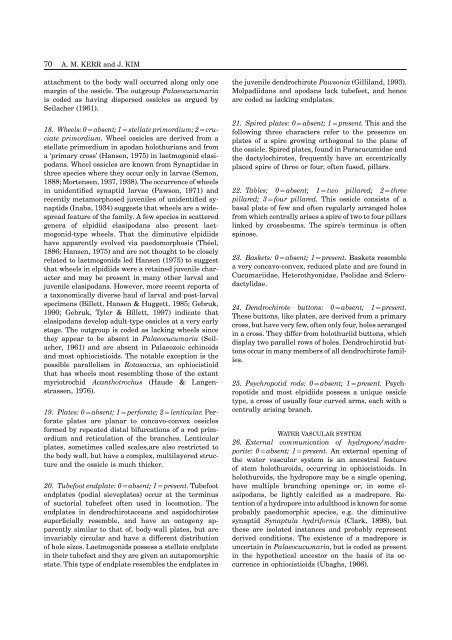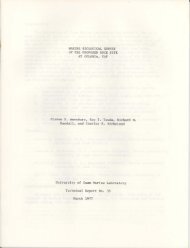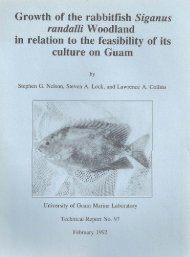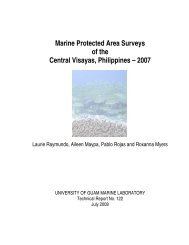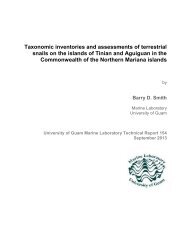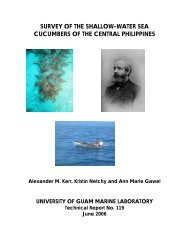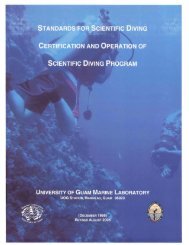Phylogeny of Holothuroidea (Echinodermata) inferred from ...
Phylogeny of Holothuroidea (Echinodermata) inferred from ...
Phylogeny of Holothuroidea (Echinodermata) inferred from ...
Create successful ePaper yourself
Turn your PDF publications into a flip-book with our unique Google optimized e-Paper software.
70 A. M. KERR and J. KIM<br />
attachment to the body wall occurred along only one the juvenile dendrochirote Pawsonia (Gilliland, 1993).<br />
margin <strong>of</strong> the ossicle. The outgroup Palaeocucumaria Molpadiidans and apodans lack tubefeet, and hence<br />
is coded as having dispersed ossicles as argued by are coded as lacking endplates.<br />
Seilacher (1961).<br />
21. Spired plates: 0=absent; 1=present. This and the<br />
18. Wheels: 0=absent; 1=stellate primordium; 2=cru- following three characters refer to the presence on<br />
ciate primordium. Wheel ossicles are derived <strong>from</strong> a plates <strong>of</strong> a spire growing orthogonal to the plane <strong>of</strong><br />
stellate primordium in apodan holothurians and <strong>from</strong> the ossicle. Spired plates, found in Paracucumidae and<br />
a ‘primary cross’ (Hansen, 1975) in laetmogonid elasi- the dactylochirotes, frequently have an eccentrically<br />
podans. Wheel ossicles are known <strong>from</strong> Synaptidae in placed spire <strong>of</strong> three or four, <strong>of</strong>ten fused, pillars.<br />
three species where they occur only in larvae (Semon,<br />
1888; Mortensen, 1937, 1938). The occurrence <strong>of</strong> wheels<br />
in unidentified synaptid larvae (Pawson, 1971) and 22. Tables: 0=absent; 1=two pillared; 2=three<br />
recently metamorphosed juveniles <strong>of</strong> unidentified sybasal<br />
pillared; 3=four pillared. This ossicle consists <strong>of</strong> a<br />
naptids (Inaba, 1934) suggests that wheels are a wide<strong>from</strong><br />
plate <strong>of</strong> few and <strong>of</strong>ten regularly arranged holes<br />
spread feature <strong>of</strong> the family. A few species in scattered<br />
which centrally arises a spire <strong>of</strong> two to four pillars<br />
genera <strong>of</strong> elpidiid elasipodans also present laetspinose.<br />
linked by crossbeams. The spire’s terminus is <strong>of</strong>ten<br />
mogonid-type wheels. That the diminutive elpidiids<br />
have apparently evolved via paedomorphosis (Théel,<br />
1886; Hansen, 1975) and are not thought to be closely<br />
related to laetmogonids led Hansen (1975) to suggest 23. Baskets: 0=absent; 1=present. Baskets resemble<br />
that wheels in elpidiids were a retained juvenile char- a very concavo-convex, reduced plate and are found in<br />
acter and may be present in many other larval and Cucumariidae, Heterothyonidae, Psolidae and Sclero-<br />
juvenile elasipodans. However, more recent reports <strong>of</strong> dactylidae.<br />
a taxonomically diverse haul <strong>of</strong> larval and post-larval<br />
specimens (Billett, Hansen & Huggett, 1985; Gebruk,<br />
24. Dendrochirote buttons: 0=absent; 1=present.<br />
1990; Gebruk, Tyler & Billett, 1997) indicate that<br />
These buttons, like plates, are derived <strong>from</strong> a primary<br />
elasipodans develop adult-type ossicles at a very early<br />
cross, but have very few, <strong>of</strong>ten only four, holes arranged<br />
stage. The outgroup is coded as lacking wheels since<br />
in a cross. They differ <strong>from</strong> holothuriid buttons, which<br />
they appear to be absent in Palaeocucumaria (Seildisplay<br />
two parallel rows <strong>of</strong> holes. Dendrochirotid butacher,<br />
1961) and are absent in Palaeozoic echinoids<br />
tons occur in many members <strong>of</strong> all dendrochirote familand<br />
most ophiocistioids. The notable exception is the<br />
ies.<br />
possible parallelism in Rotasaccus, an ophiocistioid<br />
that has wheels most resembling those <strong>of</strong> the extant<br />
myriotrochid Acanthotrochus (Haude & Langen- 25. Psychropotid rods: 0=absent; 1=present. Psychstrassen,<br />
1976).<br />
ropotids and most elpidiids possess a unique ossicle<br />
type, a cross <strong>of</strong> usually four curved arms, each with a<br />
19. Plates: 0=absent; 1=perforate; 2=lenticular. Perforate<br />
centrally arising branch.<br />
plates are planar to concavo-convex ossicles<br />
formed by repeated distal bifurcations <strong>of</strong> a rod prim-<br />
WATER VASCULAR SYSTEM<br />
ordium and reticulation <strong>of</strong> the branches. Lenticular<br />
26. External communication <strong>of</strong> hydropore/madreplates,<br />
sometimes called scales,are also restricted to<br />
porite: 0=absent; 1=present. An external opening <strong>of</strong><br />
the body wall, but have a complex, multilayered structhe<br />
water vascular system is an ancestral feature<br />
ture and the ossicle is much thicker.<br />
<strong>of</strong> stem holothuroids, occurring in ophiocistioids. In<br />
holothuroids, the hydropore may be a single opening,<br />
20. Tubefoot endplate: 0=absent; 1=present. Tubefoot have multiple branching openings or, in some elendplates<br />
(podial sieveplates) occur at the terminus asipodans, be lightly calcified as a madrepore. Retention<br />
<strong>of</strong> suctorial tubefeet <strong>of</strong>ten used in locomotion. The<br />
<strong>of</strong> a hydropore into adulthood is known for some<br />
endplates in dendrochirotaceans and aspidochirotes probably paedomorphic species, e.g. the diminutive<br />
superficially resemble, and have an ontogeny apparently<br />
synaptid Synaptula hydriformis (Clark, 1898), but<br />
similar to that <strong>of</strong>, body-wall plates, but are these are isolated instances and probably represent<br />
invariably circular and have a different distribution derived conditions. The existence <strong>of</strong> a madrepore is<br />
<strong>of</strong> hole sizes. Laetmogonids possess a stellate endplate uncertain in Palaeocucumaria, but is coded as present<br />
in their tubefeet and they are given an autapomorphic in the hypothetical ancestor on the basis <strong>of</strong> its oc-<br />
state. This type <strong>of</strong> endplate resembles the endplates in currence in ophiocistioids (Ubaghs, 1966).


